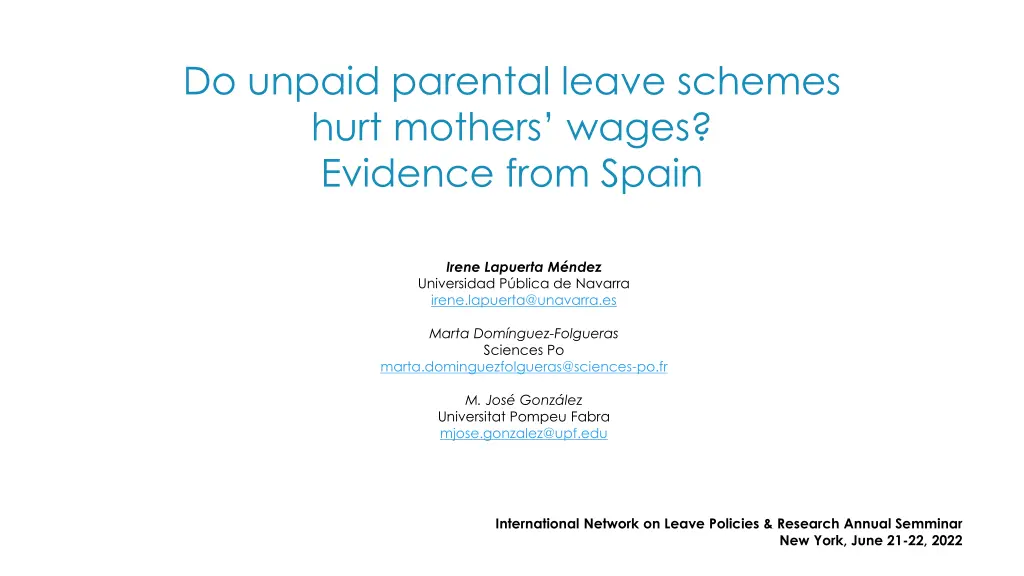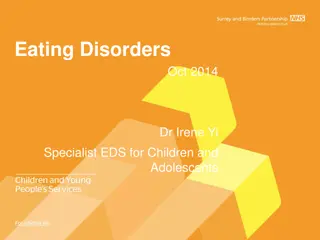
Unpaid Parental Leave Impact on Mothers' Wages: Evidence from Spain
Explore the impact of long-term and unpaid parental leave on mothers' wages in Spain, analyzing the effects of flexibility in leave design. The study delves into leave duration effects, potential negative impacts, and hypotheses regarding human capital deterioration and employer perceptions of commitment.
Download Presentation

Please find below an Image/Link to download the presentation.
The content on the website is provided AS IS for your information and personal use only. It may not be sold, licensed, or shared on other websites without obtaining consent from the author. If you encounter any issues during the download, it is possible that the publisher has removed the file from their server.
You are allowed to download the files provided on this website for personal or commercial use, subject to the condition that they are used lawfully. All files are the property of their respective owners.
The content on the website is provided AS IS for your information and personal use only. It may not be sold, licensed, or shared on other websites without obtaining consent from the author.
E N D
Presentation Transcript
Do unpaid parental leave schemes hurt mothers wages? Evidence from Spain Irene Lapuerta M ndez Universidad P blica de Navarra irene.lapuerta@unavarra.es Marta Dom nguez-Folgueras Sciences Po marta.dominguezfolgueras@sciences-po.fr M. Jos Gonz lez Universitat Pompeu Fabra mjose.gonzalez@upf.edu International Network on Leave Policies & Research Annual Semminar New York, June 21-22, 2022
Starting point: Welfare states have developed diferent policies to protect women in the labor market and countries with more genorous family policies have smaller motherhood wage gaps. However, the effects of family policies depend on the combination of the tools used and their design. Parental leave policies can have a positive effect on gender equality because they encourage mothers employment and father involvement in childcare but they can have backfire effects on women s labour market outcomes, especially when leave of absence are long. We contribute to this literature by: Exploring the effect of long-term and unpaid parental leave on mothers wages. Analysing a less explored characteristic in their design: flexibility in their use (full-time vs. part-time parental leave).
Mothers entitelments to parental leave in Spain (2022): Type of Leave Eligibility requiremets Lenght Retribuci n 180 days of contributions within the 7 years prior to the start of the leave or 360 days over the working life. Birth Leave (former maternity leave) 16 weeks 100% Until the child is 12 months old (Breast)feeding Leave 100% Only employees. No contribution requirements. Parental Leave (full-time parental leave) Until the child is three years old Unpaid Reduced working hours (part-time parental leave) Until the child is three years old Unpaid
Theories on the potencial negative impact of using parental leave on mothers wages: Deterioration on human capital (Mincer and Polachek, 1978): mothers' work experience suffers, especially with prolonged leaves of absence, since existing knowledge and skills depreciate due to lack of use, adaptability to new technologies and opportunities for training. The low commitment stigma (Albrecht et al, 1999): it is related to existing social norms in the labor market, which define the ideal worker as an individual without additional responsabilities and focused exclusively on work. Employers may interpret taking leave as a sign of low commitment to work and discriminate against mothers who interrupt their careers in promotion or salary increase processes. Family structure and resources: Mothers' work decisions depend on variables such as the number of children, partner s earnings and couples time allocations to paid and unpaid work.
Hypothesis: Hp.1. Length effects: We expect a negative association between leave duration and women wages, because leave-taking entails a deterioration of human capital or because it is interpreted as a signal of low commitment by employers. Hp. 2. Smaller effects of part-time vs. full-time parental leave: We expect that the use of part-time leave is associated with a smaller penalty than the use of full-time leave of the same durarion because both the deterioration of human capital and the signaling effect are lower.
Data: Continous Sample of Working Lives (MCVL, waves 2005-2012) Longitudinal administrative register data with individual information from : (1) Social Security system; (2) municipal registry of inhabitants; (3) income tax registers. Subsample: 135,622 women: They were between 25 and 40 years old in 2005. They worked as employees in the labour market. Shorcomings: It does not include the kinship relationship we exclude women who live with several adults and for whom it is not possible to establish the mother-child relationship. It does not identify periods of paid parental leave: maternity, paternity and (breast)feeding leave. It does not contain information on couples, nor on care values or preferences.
Method: Panel data (longitudinal) -> monthly observations for each individual during the period 2005-2012. Sample: 9,539,617 observations (a maximum of 96 per woman, if she remains during all waves) Dependent variable: the natural log of the monthly contribution base to the Social Security System (= proxy of wage). Statistical technique: lineal regression model with fixed-effects
Results from fixed effects models predicted the motherhood wage penalty by number of children. Spain: 2005-2012. Model 1 and 2 controls for age, age squared, CNM of labor experience (and its square), % of working hours, firm size, sector of activity, CNM unemployed (and its square), type of contract and period. Modelo 1 Coef. Modelo 2 Coef. Std. Err. Std. Err. Childless 1 child 2 children 3 children -- -0.052*** -0.118*** -0.160*** (.) (0.0016) (0.0024) (0.0046) -- -0.044*** -0.101*** -0.138*** (.) (0.0016) (0.0024) (0.0047) Observations: 9,539,617. CNM* full-time leave -0.012*** (0.0027) CNM* full-time leave squared 0.0002*** (0.0005) CNM* part-time leave -0.003*** (0.0002) CNM* part-time leave squared 0.00003*** (0.0000) *Cumulative number of months Source: MCVL, 2005-2012.
Predicted Values for the motherhood wage penalty by number of children and use of parental leave (1 year per child, full or part-time). Spain: 2005-2012 The results above are from the fixed-effects linear regressions on the (log) monthly wages (income contribution base) for employed women aged twenty-five to fourty five in 2005 for the period 2005-2012. The effects are calculated using model 2, with all the variables at the mean, and transforming all coefficients into percentages using the formula (?? 1) 100. FT stands for full-time and PT stands for part-time . Source: MCVL, 2005-2012.
Conclusions: Parental leave helps women to stay in the labor market, but it comes at a cost: we find that for equal lengths of both types of leaves, full-time parental leave has a higher cost than part-time leave. However, this result must be interpreted with caution: Women take part-time leave for much longer periods tan full-time leave. So, there may be some catch-up effect that would make the penalties of both types of leaves similar in the long run. We are measuring a short period (up to seven years). So, it may be the case that penalties cancel out later in the mothers carrer. Some studies show that mothers might develop strategies to compensate for the reduction in working hours, which may, in turn, reduce the penalty in the long term (Webber and Williams, 2008). Policy implications: the reform implemented in 2021 in Spain does not modify the unpaid leave policies. The positive effects that this reform might have on gender equality can be jeopardized by the negative impact of full- and part-time parental leaves on mothers wages. As a result, a revisi n of the whole parental leave system is needed.
Thank you very much for your attention!






















